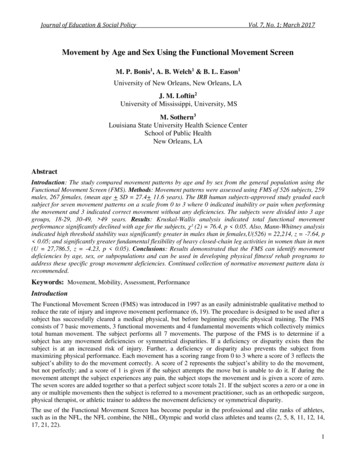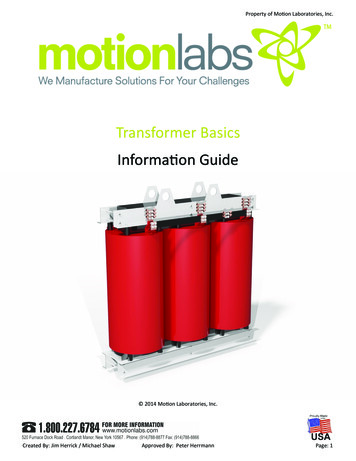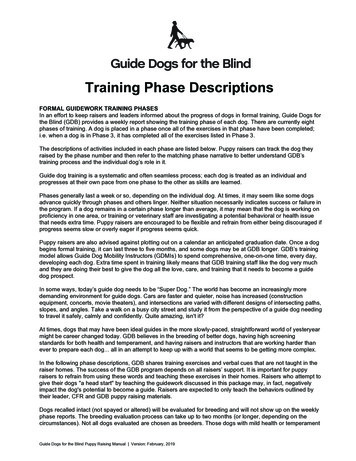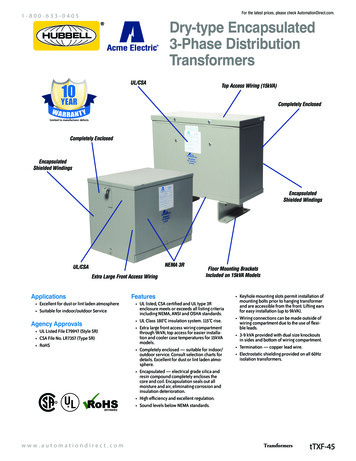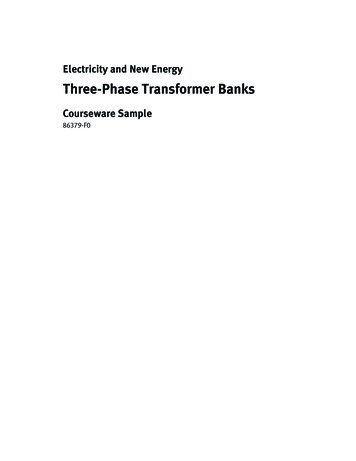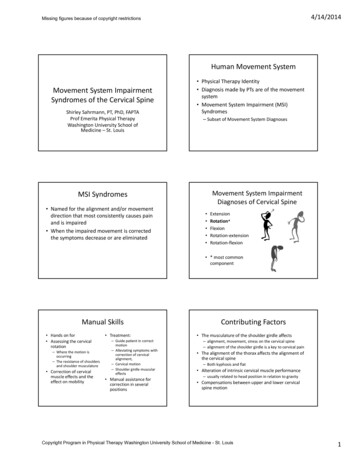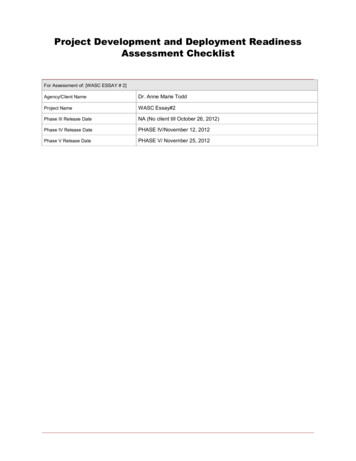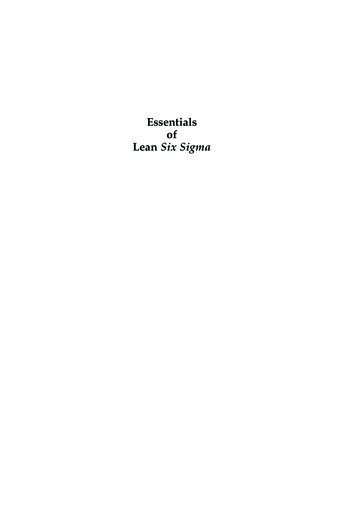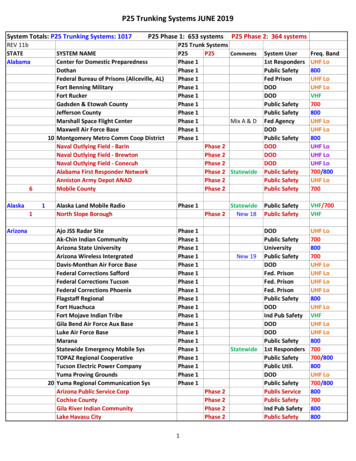
Transcription
PHASE 2:MOVEMENTTRAININGPHASE 2: MOVEMENT TRAININGAMERICAN COUNCIL ON EXERCISE All Rights Reserved1
The ability to perform movements with skill and efficiency is essentialfor health, fitness, and performance. Movement efficiency not only helpsreduce the physiological burden of performing activities of daily living, jobtasks, and sports skills, but also reduces one’s likelihood for certain typesof musculoskeletal injuries.Creating a Rubric for MovementConsequently, in order to help establish a client’s bestopportunity for long-term success, it is crucial thatappropriate movement patterns are developed andreinforced on a consistent basis within the contextof each training session. This text presents strategiesfor improving movement proficiency in the five basicmovement patterns outlined in the ACE IntegratedFitness Training (ACE IFT ) Model. Additionally,several strategies for increasing the complexity of thesemovements are discussed.To judge movement efficiency, we must have anappropriate reference for comparison. Creating a basicevaluation system is extremely helpful and will allow theprofessional to streamline this process. A rubric is a toolcommonly used in academic settings to delineate thespecific criteria for grading or scoring academic papers,projects, or tests. Rubrics help ensure consistencywhen rating these works, and help individuals betterunderstand exactly what is expected of them to performat an acceptable level. Rubrics can be used by the fitnessprofessional to ensure that all aspects of a specificmovement are being performed correctly, as well as servingas an ongoing assessment tool to measure progress. Forclients, this tool can provide a basic checklist to help guideand evaluate their own movements. Subsequently, thesedocuments may also serve as an educational tool to notjust “train,” but actually “teach” clients what efficientmovement should look like.Tables 1 through 5 provide several examples ofmovement rubrics for exercises that target the five basicmovement patterns that are central to phase 2 of the ACEIFT Model (movement training). These rubrics emphasizethe correct execution of these movements, rather thanthe potential movement compensations or imbalances.The Five Basic Movement PatternsThe ACE IFT Model identifies five basic movementpatterns: bending and lifting movements (e.g.,squatting); single-leg movements (e.g., single-leg stanceand lunging); pushing movements (e.g., primarily inthe vertical or horizontal planes); pulling movements(e.g., primarily in the vertical or horizontal planes);and rotational (spiral) movements. In many cases,when performing these movements for the first time,individuals will demonstrate faulty movement patterns.During phase 2 (movement) training, the fitnessprofessional must critically analyze potential reasons forthese issues and attempt to educate the individual onhow to perform these movements correctly.TABLE 1: MOVEMENT RUBRIC FOR THE BEND-AND-LIFT PATTERNBody RegionOptimal Movement PatternAchievedFeet/ankleFeet flat and stableYes/NoHeels in contact with groundYes/NoAligned with the hips and the feetYes/NoDirectly over, or just behind, the toesYes/NoHipsFlexed and horizontally alignedYes/NoTorsoTibia and torso are parallel to one anotherYes/NoLumbar spine remains neutralYes/NoTorso remains centered over base of : American Council on Exercise (2014). ACE Personal Trainer Manual. San Diego: American Council on Exercise;Kritz, M., Cronin, J., & Hume, P. (2009a). The bodyweight squat: A movement screen for the squat pattern. Strength &Conditioning Journal, 31, 76–85.PHASE 2: MOVEMENT TRAININGAMERICAN COUNCIL ON EXERCISE All Rights Reserved2
TABLE 2: MOVEMENT RUBRIC FOR THE LUNGEBody RegionOptimal Movement PatternAchievedFeet/ankleFront foot flat and stableYes/NoBack foot on the ball of the footwith the toes flexedYes/NoAligned with the hip and the feetYes/NoFront knee directly over the leadankleYes/NoHipsFlexed and horizontally alignedYes/NoTorsoVertical with the shoulders directlyabove the hipsYes/NoLumbar spine remains neutralYes/NoTorso remains centered over baseof : American Council on Exercise (2014). ACE Personal Trainer Manual. Kritz, M., Cronin, J., & Hume, P. (2009b). Using thebody weight forward lunge to screen an athlete’s lunge pattern. Strength & Conditioning Journal, 31, 15–24.TABLE 3: MOVEMENT RUBRIC FOR A VERTICAL PUSHING MOVEMENT FROM THE UNIVERSALATHLETIC POSITIONBody RegionOptimal Movement PatternAchievedFeet/ankleFeet flat and stableYes/NoHeels in contact with groundYes/NoAligned with the hips and the feetYes/NoDirectly over, or just behind, theballs of the feetYes/NoHipsSlightly flexed and horizontallyalignedYes/NoTorsoVerticalYes/NoLumbar spine remains neutralYes/NoTorso remains centered overbase of ontally alignedYes/NoArmsExtended fully overhead, palmsfacing forward, with the upperarms aligned with the earsYes/NoKneesFeedbackSource: Earle, R.W. & Baechle, T.R. (2008). Resistance training and spotting techniques. In: Baechle, T.R. & Earle, R.W. (Eds).Essentials of Strength Training and Conditioning (3rd ed.). Champaign, Ill.: Human Kinetics.PHASE 2: MOVEMENT TRAININGAMERICAN COUNCIL ON EXERCISE All Rights Reserved3
TABLE 4: MOVEMENT RUBRIC FOR A HORIZONTAL PUSHING MOVEMENT FROM THE PRONE POSITION (E.G., PUSH-UP)Body RegionOptimal Movement PatternAchievedFeet/ankleAligned with the knees and dorsiflexed throughout duration of exerciseYes/NoKneesAligned with the hips and the feet throughout duration of exerciseYes/NoHipsHorizontally aligned with one another throughout duration of exerciseYes/NoAligned with the ankles, knees, and shoulders throughout duration of exerciseYes/NoNeutral and aligned with the hips throughout duration of exerciseYes/NoTorso remains centered over base of support throughout duration of exerciseYes/NoLumbar spine is neutral throughout duration of exerciseYes/NoHeadNeutral throughout duration of exerciseYes/NoShouldersLevel/horizontally aligned throughout duration of exerciseYes/NoTorsoFeedbackHeld back and down away from the earsScapulaNeutral, with fluid controlled movement against the rib cage throughoutduration of exerciseYes/NoArmsExtended with the palms directly under the shoulders and arms tucked tothe sides on upward phase of moment (starting position)Yes/NoArms flexed so that upper arms are parallel, or slightly below parallel tothe ground with the elbows tucked to the sides (down position)Yes/NoSources: American Council on Exercise (2014). ACE Personal Trainer Manual. San Diego: American Council on Exercise; Kritz, M., Cronin, J., & Hume, P. (2010).Screening the upper-body push and pull patterns using bodyweight exercises. Strength & Conditioning Journal, 22, 72–82.TABLE 5: MOVEMENT RUBRIC FOR BODY-WEIGHT BENT-OVER ROW PATTERNBody RegionOptimal Movement PatternAchievedFeet/ankleFeet flat and stableYes/NoHeels in contact with groundYes/NoAligned with the hips and the feetYes/NoDirectly over, or just behind, theballs of the feetYes/NoHipsFlexed and horizontally alignedYes/NoTorsoParallel to the ground/flat backpositionYes/NoLumbar spine neutralYes/NoKneesFeedbackYes/NoTorso remains centered overbase of y alignedYes/NoHeld down and back from the earsYes/NoScapulaRetracted and depressedYes/NoArmsHanging toward the ground withthe elbows fully extended, handspronated, with the upper arms alignedwith the shoulders (starting position)Yes/NoElbow tucked to the sides during pullYes/NoSources: American Council on Exercise (2014). ACE Personal Trainer Manual. San Diego: American Council on Exercise; Kritz,M., Cronin, J., & Hume, P. (2010). Screening the upper-body push and pull patterns using bodyweight exercises. Strength &Conditioning Journal, 22, 72–82; Earle, R.W. & Baechle, T.R. (2008). Resistance training and spotting techniques. In: Baechle,T.R. & Earle, R.W. (Eds). Essentials of Strength Training and Conditioning (3rd ed.). Champaign, Ill.: Human Kinetics.PHASE 2: MOVEMENT TRAININGAMERICAN COUNCIL ON EXERCISE All Rights Reserved4
Utilizing Technology in Conjunctionwith Movement RubricsWhile important for the fitness professional to understand,focusing on the compensations and imbalances causes oneto think more about the problem than the solution. Thus,using positive wording within the context of the movementrubric helps direct the individual’s attention to whatactions should be focused on to correct the poor movementpattern, rather than the movement the fitness professionalwould like to him or her to avoid.Each rubric has columns for the body region to assess,the optimal movement pattern for that region, and adelineation of whether this movement was achieved, aswell as a feedback column in which the professional canlist specific teaching cues and key points to focus onshould improvement be required. Remember, these cuesshould focus on the desired movement outcome. Forinstance, if the feet are pronating, the fitness professionalshould emphasize keeping the weight evenly distributedover the feet and keeping the knees aligned with the hipsand feet. The professional should not say, “Don’t turn thefeet inward,” as this emphasizes the incorrect movementpattern and may unintentionally direct the client’s focus tothis movement rather than the desired pattern. Note thatthis rubric also utilizes a bottom-up approach by lookingat each subsequent joint in the kinetic chain. This canhelp the fitness professional zero in on problem areas andassist in determining the most effective training strategy tosolve a compensatory movement pattern. Furthermore, thistechnique also tends to appeal to both kinesthetic learnersand those individuals who tend to learn best by havinginformation displayed to them in words.In recent years, with the availability and accessibilityof several new sports video analysis applications (apps)available for both tablet and cell phone use, movementassessment has become significantly easier. Many of theseapplications are free or can be purchased for a nominal feeonline. These apps allow the fitness professional and clientto instantly review video in real time and slow motion.Additionally, several marking tools are available withinthese apps that allow for quick and easy biomechanicalbreakdown of movements. Not only does this provide anexcellent tool for assessing and reassessing movement overtime, but it also can be used to provide instant feedback toclients who tend to be more visual learners.SummaryDeveloping appropriate movement patterns is essentialfor improving fitness and performance, enhancingmovement efficiency, and reducing the risk of potentialchronic and acute injuries. Creating a movement rubriccan not only aid the fitness professional in assessing aclient’s movement skills, but also be used as a teachingtool for clients to better understand what movements arerequired to execute a task effectively. Furthermore, theintegration of new technologies can also be employed tobetter appeal to specific learning styles, improve bodyawareness, and provide an easily accessible reference forfuture improvement. ÂReferencesAmerican Council on Exercise (2014). ACE Personal Trainer Manual.San Diego: American Council on Exercise.Earle, R.W. & Baechle, T.R. (2008). Resistance training and spottingtechniques. In: Baechle, T.R. & Earle, R.W. (Eds). Essentials of StrengthTraining and Conditioning (3rd ed.). Champaign, Ill.: Human Kinetics.Kritz, M., Cronin, J., & Hume, P. (2010). Screening the upper-bodypush and pull patterns using bodyweight exercises. Strength &Conditioning Journal, 22, 72–82.Kritz, M., Cronin, J., & Hume, P. (2009a). The bodyweight squat:A movement screen for the squat pattern. Strength & ConditioningJournal, 31, 76–85.Kritz, M., Cronin, J., & Hume, P. (2009b). Using the body weightforward lunge to screen an athlete’s lunge pattern. Strength &Conditioning Journal, 31, 15–24.PHASE 2: MOVEMENT TRAININGAMERICAN COUNCIL ON EXERCISE All Rights Reserved5
Sources: American Council on Exercise (2014). ACE Personal Trainer Manual. San Diego: American Council on Exercise; Kritz, M., Cronin, J., & Hume, P. (2010). Screening the upper-body push and pull patterns using bodyweight exercises. Strength & Conditioning Journal, 22, 72–82. TABLE

